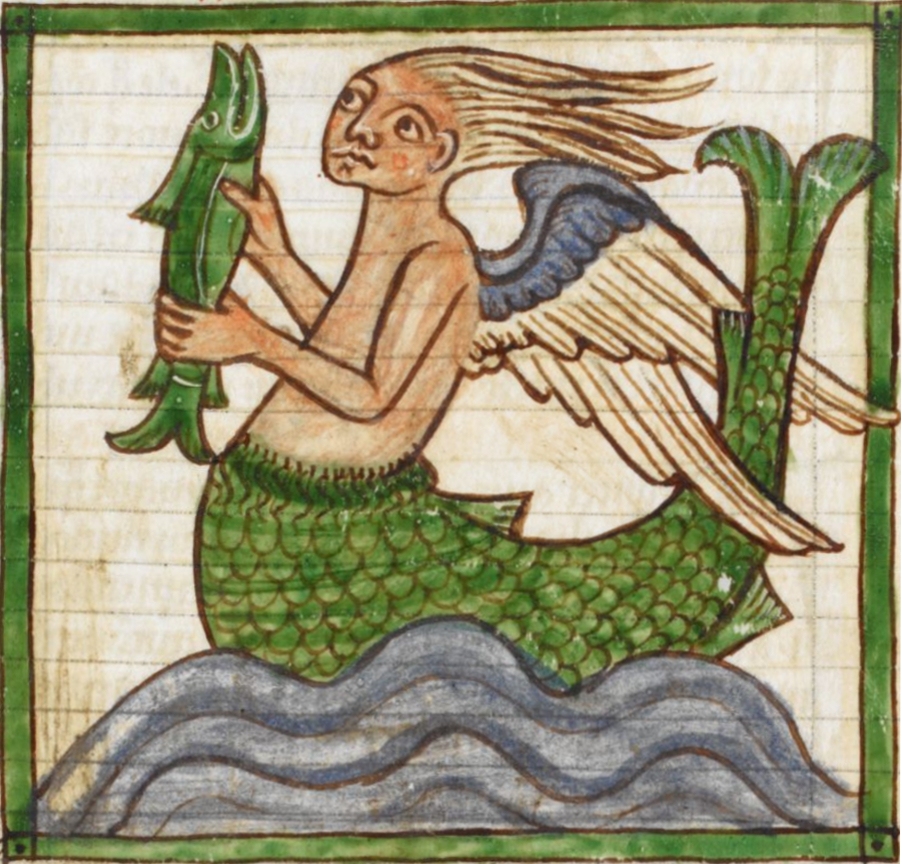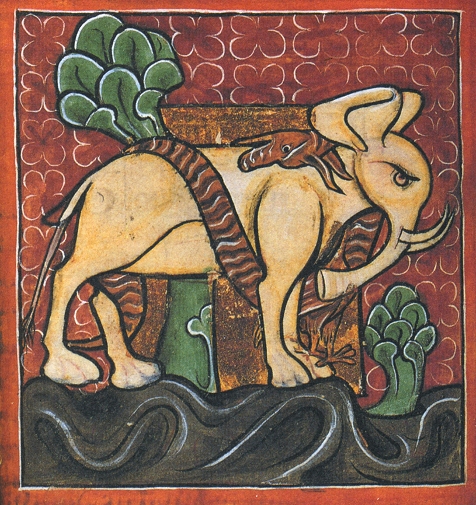- Banshee
- A spirit of Irish and Scottish legend, sometimes known in Scotland as the Little Washer of Sorrow. She has only one nostril, a large projecting front tooth, long flowing hair, webbed feet and red eyes. She spends her life by the river where she can be heard constantly wailing, while washing the clothes of a man doomed to die. If she is captured while washing in the river she must reveal the name of the man destined to die, and then grant three wishes. In Scotland the banshee/banshi had a tendency to marry mortals.
- Baobhan Sith
- An evil spirit found in isolated parts of Scotland. There was a tribe of these spirits which sometimes appeared as hooded crows, but more commonly they were seen as beautiful girls with long trailing green dresses which hid their deer's hooves. They lured young men into their presence and then sucked their blood. One example of their evil ways is related in a Ross-shire tale: four men out hunting were entertained by four baobhan siths; only one realized the danger in time and escaped to tell the tale.
- Bargvest
- Spirit of Celtic mythology usually appearing in the form of an animal, but occasionally in human form. It had eyes like burning coals, claws, horns, a tail, and wore a clanking chain. This spirit appeared most often in fishing villages. If it died and there was a bargvest funeral, this was seen by the fishing community as a portent of impending tragedy. In Yorkshire they were said to haunt the neighborhood of churchyards.
- Barrow-Wight or Haug-Bui
- Ghosts associated in the Anglo-Saxon period with Bronze Age barrow graves. They were believed to reside in the barrow and attacked anyone attempting to remove the treasure. St. Guthlac, who lived in a barrow in Cambridgeshire, was continually having to defend himself from these creatures. They were described by St. Guthlac's biographer as having large heads, long necks and lean faces. Their beards were filthy, teeth were like horses' teeth, and they had loud grating voices. Their knee-joints bent backward but toes still faced front. Other sources stated that they could only be killed by cutting off their heads and then placing them at their knees. Anyone who saw a barrow-wight either went mad or was killed by them.
- Biasd Na Srogaig
- Closely resembling a unicorn, it lived only in small lochs on the Isle of Skye, and was a huge clumsy creature with very long legs. Its name means 'the beast of the lowering horn'.
- Bishop Fish
- These fish emphasize a medieval tradition that everything in the air or on the earth had a double in the sea. The bishop fish had an angular head, a scaly body with two claw-like fins in the place of arms, and a fin-like cloak. Its legs appeared to be clothed in rubber waders. Its origin was possibly the cast-up body of a giant squid.
- Black Dog
- The size of a young calf, with a long black shaggy coat and bright fiery eyes, it was harmless if left alone; but if a human spoke to a black dog or attempted to touch it he was instantly struck dumb and died. They appear in English fairy tales.
- Blue Men of Minch
- These were mermen of a very local kind, found nowhere except in the strait between Long Island and Shiant Island in the Hebrides. They were blue from head to toe. They were particularly affected by the spoken word; they could be deceived if addressed in rhymes. No man needed to fear them if he could have the last word. They were known for their power to conjure storms; when they slept the weather was fine. A local tradition held that they were fallen angels.
- Boggart
- A mischievous spirit of the brownie type found in the North of England, particularly Yorkshire. A favorite occupation of these creatures was to indulge in poltergeist activities. They are usually described as small, basically human creatures, but with animal traits such as fur or tails. A common story tells how a family plagued by a boggart decided to move. When their belongings were loaded on a cart, a neighbor came up and said: "So you're moving?" The boggart answered from the back of the cart: "Aye, we're moving."
- Bogle
- Scottish version of the Boggart.
- Boobrie
- One of the shapes a Water Horse could take. It was a vast bird shaped like a great northern diver but exaggerated with white patches on its neck and breast. Its footprints covered the space of a pair of large antlers, and its voice was like the roar of an angry bull. This monster haunted freshwater and sea lochs of Argyllshire, Scotland and made forays into the surrounding country where it feasted on sheep and cows.
- Brollachan
- A shapeless thing found in tales of the Western Highlands of Scotland, responsible for many weird or inexplicable occurrences.
- Brownie
- Small shaggy creature of more or less human form, raggedly dressed, with hardly any nose. Found mainly in northern England and Scotland. They did odd jobs about the house, and the only payment they would accept was bread and milk. If a human tried to offer them more they would simply vanish.
- Burach-Bhadi or Wizard's Shackle
- Eel or leech with nine eyes in its head and back, all of which squinted. Found in fords in the Western Highlands of Scotland, and also reported in Perthshire. It amused itself by winding itself around the hooves of passing horses and drowning them so that it could then suck their blood.
- Bwbachod
- A Welsh brownie who was extremely friendly and industrious, who would work for anyone except teetotalers and dissenters.
- Cailleach Bhuer
- A giant hag in Scottish legend who symbolized winter. She could change her form when necessary, either to that of a serpent or of a very beautiful maiden. She could also change from flesh to stone at will. She carried a staff which was captured by Spring, who flung it into the holly bushes. No grass would ever grow where the staff fell. She was the patroness of deer and wild boar. Many hills including Ben Nevis and Schiehallion are associated with her.
- Ce Sith
- A dog as large as a bull with a dark green coat which haunted parts of the highlands of Scotland.
- Cir Sith
- A fairy hound found in the western Scottish Isles. It was the size of a two-year-old cow, and green in color. The cir sith had a long tail which was usually coiled on its back, sometimes braided like the straw rug of a pack-saddle. It was kept as watchdog in the fairy knowe, but did occasionally run loose. It moved swiftly, making a noise like a galloping horse, leaving huge footprints. It trailed travelers, barked three times, and at the third it overtook its prey and pulled him down.
- Crom Crumh Chomnaill
- A Gogmagog type of monster (see Giants) with very long hind-legs, so that he was taller than trees and buildings. From time to time it ejected a ball of fire from its mouth. St. Maccrid killed him by touching him with part of his own clothing, the infinite goodness of the saint conquering evil.
- Dale Cockatrice
- A beast with the wings of a fowl, tail of a dragon and the head of a cockerel it takes its name from being produced from a seven year old cock's egg, fertilized by a dragon when the dog star Sirius was in the ascendant, and hatched by a toad. To look the beast directly in the eye was to cause instant death. At Dale, three miles north west of Lerwick in the Shetland Isles of Scotland a woman is said to have discovered the egg of a cockatrice which she placed under one of her hens to hatch. The creature hatched, ate the hen's chicks and made its home in a pile of peat. The pile of peat in which it lived was set on fire and the Dale Cockatrice died.
- Daoine Sidhe
- Heroic Irish fairies, said by some to be fallen angels too good for hell. They have a particular liking for beautiful mortals whom they steal for brides.
- Devil's Dandy Dogs
- A pack of fire-breathing black hounds found in Cornwall. They had bright fiery eyes, and followed the devil over lonely moors on stormy nights. If they captured humans they tore them apart limb by limb. The only know way to deter these monsters was for a man to pray sincerely.
- Dierach Ghlinn Eitidh
- A one-handed, one-eyed and one-legged ghoul found in the west Scottish highlands.
- Dobie
- One of the Brownie clan. Found most commonly in Yorkshire, he was sometimes taken for a ghost.
- Donn of Cualgne (Cooley)
- Supernatural bull described in the Irish poem The Cattle Raid of Cooley, he was especially known for 'the fifty youths who engaged in games, on his fine back, finding room every evening to play draughts and engage in riotous dancing', by 'the hundred warriors he screened from heat and cold under his shadow and shelter.' 'His musical lowing every evening as he returned to his shed and byre was music enough and delight enough for a man in the north and south and in the west and in the middle of the cantered of Coolly.' His lowing alone was enough to put all the cows in calf.
- Dragons
- Dragons almost seem to exist in myth and legend simply so a hero can kill them. In England knights who achieved fame against dragons include Guy of Warwick, Sir John Conyers and Moore of Warncliffe. The last agreed to fight the dragon of Wantley which had plagued the area and eaten three children. In return for his feat Moore demanded ' a fair maid of sixteen that's brisk, and smiles about the mouth: her hair as black as sloe'.
- Dragon-Mermaid
- Found in Celtic myth, she gave favors in the form of heirs to childless couples, but always demanded some sacrifice and laid a curse on the family if her wish was not fulfilled.
- Dun Cow of Warwick
- A monstrous cow which was supposed to have come from Shropshire in the tenth century, where she provided milk for local giants. She used the stone circle on Staple Hill as a cow-pen. The Dun Cow produced an endless supply of milk, but an old crone, doubting this, produced a sieve to try the cow. The cow was so insulted that her yield should be questioned that she broke loose and wandered into Warwickshire, where she was killed by Guy of Warwick on Dunsmore Heath. Sir Guy had already made his reputation for destroying monsters; a dragon in Northumberland, the Windsor boar and two Danish giants which had come to England.
Photo credits: (Related Resources) (1) Harley MS 3244, British Library Digitised Manuscripts, PD-Art, Wikimedia Commons, (2) MS Body 764, Bodleian Library, Oxford, England, PD-Art, Wikimedia Commons

